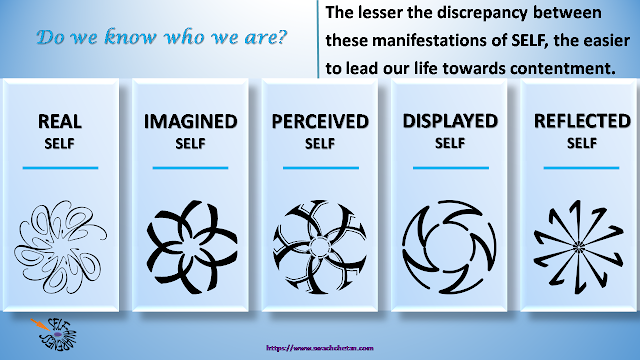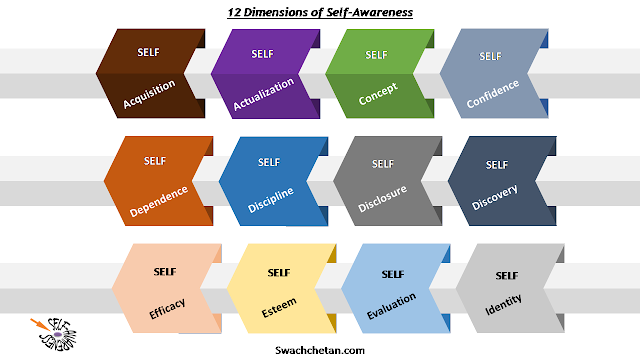Self-Awareness
We may be aware of who we are, what we do, and how we
think, feel, and perceive. However, when the question of ‘why’ comes, there is
a major discrepancy between our knowledge of ourselves and our real selves. We
assume that we know ourselves well but in reality, we are affected by “Conscious
Capture” where our knowledge has been
borrowed from others.
Knowing
us
What we know about ourselves is different from what
others know about us.
Can we compare one to the other? Are we matching our
knowledge with that of others?
Or are we having a distinct understanding of ourselves
irrespective of what others think of us?
Let us find out!
Let
us try this experiment
Look at your hands in the figure below. The first one
is your right hand and the second one is your left hand. Observe that the
thumbs of both hands are nearer to each other.
The secret is, that this is what others see when you show
your hands. You will not be able to see your two hands this way, except only in
the mirror.
The way you see your own hands is shown underneath.
Observe that the thumbs are on the opposite side.
Who is the real you?
Is what others see as you the real one?
Or what you see is the real one?
Intangibles
If what is tangible is so complicated, then what about
intangible things?
Are our thoughts, feelings, perceptions, ideas,
imagery, etc., are ours or they molded by others for us to use?
Who
is controlling us?
We always feel that we are in control. We assume that we are conscious of what we do and why we do it!
In reality, we can only provide
explanations for our behavior after it has happened. We do not know what
exactly we will do in a given situation because our response depends on the
context, circumstances, people around us, people with us at the moment, people
who are in our minds, people who may come to know about the situation, etc.
The
mirror
How do we internalize others’ ideas
and thoughts as our own? Let us consider
that our life is like a huge mirror. We can see our image when the mirror is
intact but we can only see a small portion of us if the mirror is broken into
small pieces.
The essence of life is to combine
these pieces into a manageable whole so that we can understand ourselves as a complete
people. However, as we grow, each individual we come across sees a small
portion of this mirror and conveys to us the ‘fact’ that we are like that.
The Software
When several people tell about us the
way they see us, we tend to arrive at an approximation of our personality
through these bits of information. We never would know who we are actually, and
that exactly is the purpose of life – to realize one’s self. We start thinking
the way we are programmed to think, we start perceiving the world the way we
are trained to perceive it, we start being emotional the way we receive them
from others and we start acting the way we are expected to act.
Knowledge
about Self
We know so much about things,
computers, machines, customs, traditions, space, etc., but we know very little
about ourselves. The less we know about ourselves the greater our inability to
deal with situations and the greater will be our distress.
Do
we know who we are?
Technically speaking, there
is a world of difference between our ‘real self’ and ‘imagined self’. Compare
these to our ‘perceived self’ and you see a varied array of behaviors that are
not part of the first two. Then there is our ‘displayed self’ that happens with
or without our intention. Once again, all these are different from our
‘reflected self’.
Five Manifestations of Self
Real Self
Priorities:
A true self manifests over time wherein we set our priorities. We form our
likes and dislikes, and sometimes we do not even know why such priorities have
come about! We prefer certain things over other things, a few people over
others, and some ideas over others. Our wants
and needs are determined by so many factors
that we lose track of how our priorities have manifested. Somehow, we can’t
live without our choices.
Goals:
Our wants and needs prompt us toward setting our goals.
We are energized to move toward the fulfillment of our goals, irrespective of
the hindrances we encounter. We are not sure whether our goals are voluntary,
involuntary, or habitual, yet we have all of them that characterize our
personality. We can’t even distinguish between realistic and unrealistic goals
but keep both of them as our own. (See Can
we live without goals? for a complete
description of these concepts).
Aspirations:
Once we are sure that our needs and wants will be fulfilled, they give rise to
our aspirations.
Sometimes our aspirations are influenced and guided by others’ whims and
fancies rather than by our insights. In most instances, we may set idealistic
aspirations without knowing whether we are capable of achieving them. However,
we are still aware of what our aspirations are.
Achievements:
Most of our failures in achievements arise because we think we can control the
outcome. In reality, as pointed out elsewhere,
we can only control our efforts but not the outcome of our efforts. We relegate
most of our achievements as insignificant because we tend to compare others’
achievements with ours. However, when prompted, we can enlist our achievements
that form a part of our real ‘self’.
Imagined Self
Desires:
In addition to needs, wants, and aspirations, we have desires that camouflage
as one of them. Technically, desires don’t appear in the realm of motivation as
they can’t fulfill any aspect of the Motivation
Cycle. However, we tend to imagine that we
deserve the things we desire.
Dreams:
The daydreams we generate are also part of our imagination with or without
a structural and functional basis. One can be free to dream whatever one wants,
but unless these dreams are distinguished from needs and wants they become a
hindrance to personal growth.
Apprehensions:
The worries, fears, and anxieties that we carry are mostly part of our imagined
‘self’. We are even afraid of finding out whether these are real or apparent.
We abhor friends and relatives trying to reason with us and we go to any
lengths to demonstrate that our apprehensions are justified.
Attitudes:
Our ideas, opinions, and beliefs including our biases, prejudices, stereotypes,
and superstitions form our attitudes.
We go to any length to argue and substantiate that our attitudinal systems are
real when in reality, they are primarily parts of the collective imagination of
the societies in which we live.
Perceived Self
Status: We
perceive ourselves as having a status and strive to not only retain the present
status but also try to enhance our status in society. Our self-awareness is
determined by who we are and how important our place in the community is.
Position:
We also perceive our roles and responsibilities and include them in our
self-awareness. The position we occupy could be formal or informal but we are
proud of it and we justify it.
Employment:
We always perceive ourselves in concurrence with our employment. Both our
status and position in society are determined by the nature of our employment.
We feel worthless when we are unemployed. We accept our place in the hierarchy
of the workforce and this determines our behavior with others.
Family: We
always include our parents, relatives, siblings, spouses, children, grandchildren,
and even friends in our interactions. Every thought and action that appears in
us is an expression of our relationship
with our kith and kin.
Displayed Self
Esteem:
The value we hold in a society where others can gauge our status becomes
important for us. We display this esteem and we are aware of such a display.
Connections:
We are equally aware of who we know. It could be friends, relatives, or mere
acquaintances. We would like to flaunt our connections in almost all our
interactions.
Memberships:
We cannot remain aloof from society. We pick institutions and organizations to
which we can belong to. We are proud of our association with these bodies.
Property:
We would like to own as much as possible and we try to emphasize our ownership
wherever we go. It could be a simple thing like a mobile phone, an expensive
car, or a house, we want to acquire as much as we can, even if they are bought
on loans.
Reflected Self
Consistency:
We are aware of what people recognize in terms of consistency in our behavior.
Are we predictable in our thoughts and actions?
Reliability:
Another aspect that gets reflected is the amount of trust others can place in
us. We strive to improve our reliability as much as possible so that no one can
suspect our intentions and conduct.
Approachability:
How easily we are available to others is something we make sure of. We readily
reveal our identity so that others can approach us without difficulty.
Kindness:
Do we show our sympathy when necessary? Do we want to be gentle in our
interactions? We don’t want anyone including strangers to consider us as
dangerous.
Thus the real self is the
one we truly are that is obvious in our priorities, goals, aspirations, and
achievements. This might differ from an imagined self, manifested by our
desires, dreams, apprehensions, and attitudes. Our perceived self tells about
our status, position, employment, and family. Irrespective of our imagined self
we make sure our displayed self-esteem, connections, memberships, and property.
Finally, our reflected self shows our consistency, reliability,
approachability, and kindness.
The lesser the discrepancy between these manifestations of SELF, the easier to lead our life toward contentment.
HERE LIES THE ANSWER TO A CLEAN CONSCIOUSNESS
12 Dimensions of Self-Awareness
The following aspects are covered under Self-awareness.
Self-Acquisition
Enhancing your
Abilities
Skills
Knowledge
Habits
Assets
Accountability
Self-Actualization
Achievement in
your
Education
Employment
Marriage
Raising
Children
Wealth Creation
Retirement
Self-Concept
Beliefs about
your
Readiness
Inclinations
Predispositions
Reactions
Interactions
Purposefulness
Self-Confidence
Relying on your
Tendencies
Responses
Morale
Aspirations
Achievements
Negations
Self-Dependence
Independent in your
Thoughts
Perceptions
Emotions
Opinions
Beliefs
Attitudes
Self-Discipline
Regulating your
Rules
Regulations
Morality
Rights
Duties
Positives
Self-Disclosure
Revealing your
Hopes
Limitations
Apprehensions
Intentions
Strengths
Weaknesses
Self-Discovery
Realizing your
Goals
Needs
Wants
Desires
Advantages
Shortcomings
Self-Efficacy
Ensuring your
Excellence
Efficiency
Usefulness
Propensity
Adaptability
Productivity
Self-Esteem
Respecting your
Worthiness
Roles
Responsibilities
Humility
Involvement
Contribution
Self-Evaluation
Judging your
Performance
Effectiveness
Flexibility
Enhancement
Value-addition
Conformity
Self-Identity
Accepting your
Lineage
Geographical
Status
Customs
Traditions
Limitations
Merits
All Twelve Dimensions of Self-Awareness
28
Terms Depicting Self-Awareness
Other interchangeable terms concerning‘Self-Awareness’
1.
Self-acceptance
2.
Self-accomplishment
3.
Self-assessment
4.
Self-centered
5.
Self-competence
6.
Self-conscious
7.
Self-continent
8.
Self-control
9.
Self-defeating
10.
Self-development
11.
Self-enhancement
12.
Self-exploration
13.
Self-fulfillment
14.
Self-improvement
15.
Selfish
16.
Self-management
17.
Self-mastery
18.
Self-possession
19.
Self-regard
20.
Self-regulation
21.
Self-reliant
22.
Self-respect
23.
Self-Restraint
24.
Self-satisfaction
25.
Self-sufficiency
26.
Self-sustained
27.
Self-understanding
28.
Self-worth
Transforming Difficulty to Ease
Converting Weakness to Strength
Who is in charge of our lives?



































Please do not include any spam links in the comment box.